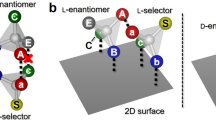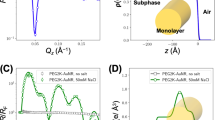Abstract
Molecular interaction between nucleic acid bases and amino acids is a fundamental process in biology. The adsorption of the molecules on surfaces provides the opportunity to study such interactions in great detail by exploiting the high-resolution imaging capabilities of scanning tunnelling microscopy (STM). The chemisorption of prochiral molecules, such as adenine, on a metal surface causes the adsorbed species to become chiral1. Subsequent interactions with inherently chiral molecules may then lead to the formation of diastereoisomers, if the enantiomeric interaction process is sufficiently strong. In the case of adenine adsorption on Cu{110}, the chiral adsorbates form homochiral chains. Here, we show that the adenine chain direction is fully correlated with the chirality, and that the α-amino acid, phenylglycine, shows a strong chiral preference in its interaction with these chains. STM images clearly demonstrate that S-phenylglycine (R-phenylglycine) binds only to chains rotated 19.5° (anti-) clockwise from the [001] direction. Closer examination reveals that the enantiomeric interaction involves double rows of phenylglycine molecules and the adenine chains. This is the first observation at the molecular level of diastereoisomeric interaction, and demonstrates that STM is a powerful method for studying the details of these interactions.
This is a preview of subscription content, access via your institution
Access options
Subscribe to this journal
Receive 12 print issues and online access
$259.00 per year
only $21.58 per issue
Buy this article
- Purchase on Springer Link
- Instant access to full article PDF
Prices may be subject to local taxes which are calculated during checkout



Similar content being viewed by others
References
Chen, Q., Frankel, D.J. & Richardson, N.V. Self-assembly of adenine on Cu(110) surfaces. Langmuir 18, 3219–3225 (2002).
Chen, Q., Lee, C.W., Frankel, D.J. & Richardson, N.V. The formation of enantiospecific phases on a Cu{110} surface. Phys. Chem. Commun. 9, 41–44 (1999).
Lorenzo, M.O., Baddeley, C.J., Muryn, C. & Raval, R. Extended surface chirality from supramolecular assemblies of adsorbed chiral molecules. Nature 404, 376–379 (2000).
Marti, E.M., Barlow, S.M., Haq, S. & Raval, R. Bonding and assembly of the chiral amino acid S-proline on Cu(110): the influence of structural rigidity. Surf. Sci. 501, 191–202 (2002).
Zhao, X.Y., Zhao, R.G. & Yang, W.S. Scanning tunneling microscopy investigation of L-lysine adsorbed on Cu(001). Langmuir 16, 9812–9818 (2000).
Stevens, F., Dyer, D.J. & Walba, D.M. Direct observation of enantiomorphous monolayer crystals from enantiomers by scanning tunneling microscopy. Angew. Chem. Int. Edn Engl. 35, 900–901 (1996).
Yablon, D.G., Guo, J., Knapp. D., Fang. H. & Flymm, G.W. Scanning tunneling microscopy investigation of a chirally pure molecule at the liquid-solid interface: Unambiguous topographic markers. J. Phys. Chem. B 105, 4313–4316 (2001).
Ernst, K.H., Kuster, Y., Fasel, R., Müller, M. & Ellerbeck, U. Two-dimensional separation of [7]helicene enantiomers on Cu(111). Chirality 13, 675–678 (2001).
Fang, H.B., Giancarlo, L.C. & Flynn, G.W. Direct determination of the chirality of organic molecules by scanning tunneling microscopy. J. Phys. Chem. B 102, 7311–7315 (1998).
Yablon, D.G., Giancarlo, L.C. & Flynn, G.W. Manipulating self-assembly with achiral molecules: An STM study of chiral segregation by achiral adsorbates. J. Phys. Chem. B 104, 7627–7635 (2000).
Smith, D.P.E. Defects in alkylcyanobiphenyl molecular crystals studied by scanning tunneling microscopy. J. Vac. Sci. Technol. B 9, 1119–1125 (1991).
De Feyter et al. Homo- and heterochiral supramolecular tapes from achiral, enantiopure and racemic promesogenic formamides: Expression of molecular chirality in two and three dimensions. Angew. Chem. Int. Edn Engl. 40, 3217 (2001).
Kühnle, A., Linderoth, T.R., Hammer, B. & Besenbacher, F. Enantiomeric interactions in dimerization of adsorbed cysteine observed by scanning tunnelling microscopy. Nature 415, 891–893 (2002).
Shishkin, O.V., Gorb, L. & Leszczynski, J. Conformational flexibility of pyrimidine rings in adenine and related compounds. Chem. Phys. Lett. 330, 603–611 (2000).
Booth, N.A. et al. Structure determination of ammonia on Cu(110) — a low-symmetry adsorption site. Surf. Sci. 387, 152–159 (1997).
Mocuta, D., Ahner, J. & Yates, J.T. Adsorption and electron-stimulated dissociation of ammonia on Cu(110): an ESDIAD study. Surf. Sci. 383, 299–307 (1997).
Davies, P.R. & Keel, J.M. The reaction of carbon dioxide with amines at a Cu(211) surface. Surf. Sci. 469, 204–213 (2000).
Barlow, S.M., Kitching, K.J., Haq, S. & Richardson, N.V. A study of glycine adsorption on a Cu{110} surface using reflection absorption infrared spectroscopy. Surf. Sci. 401, 322–335 (1998).
Hasselstrom, J. et al. The bonding and electronic structure changes upon adsorption of important functional groups: Glycine on copper. J. Phys. Chem. B 104, 11480–11483 (2000).
Booth, N.A. et al. Determination of the local structure of glycine adsorbed on Cu(110). Surf. Sci. 397, 258–269 (1998).
Chen, Q., Frankel, D.J., Lee, C.W. & Richardson, N.V. Linear dichroism electron scattering from chiral surfaces. Chem. Phys. Lett. 349, 167–171 (2001).
Williams, J., Haq, S. & Raval, R. The bonding and orientation of the amino acid L-alanine on Cu{110} determined by RAIRS. Surf. Sci. 368, 303–309 (1996).
Chen, Q., Frankel, D.J. & Richardson, N.V. Chemisorption induced chirality: glycine on Cu{110}. Surf. Sci. 497, 37–46 (2002).
Lukas, F., Witte, G. & Wöll, C. Novel mechanism for molecular self-assembly on metal substrates: unidirectional rows of pentacene on Cu{110} produced by substrate mediated repulsion. Phys. Rev. Lett. 88, 28301 (2002).
Author information
Authors and Affiliations
Corresponding author
Ethics declarations
Competing interests
The authors declare no competing financial interests.
Rights and permissions
About this article
Cite this article
Chen, Q., Richardson, N. Enantiomeric interactions between nucleic acid bases and amino acids on solid surfaces. Nature Mater 2, 324–328 (2003). https://doi.org/10.1038/nmat878
Received:
Accepted:
Published:
Issue Date:
DOI: https://doi.org/10.1038/nmat878
This article is cited by
-
Breakdown of chiral recognition of amino acids in reduced dimensions
Scientific Reports (2020)
-
Homochiral polymerization-driven selective growth of graphene nanoribbons
Nature Chemistry (2017)
-
Fundamental Investigations of Enantioselective Heterogeneous Catalysis
Topics in Catalysis (2011)
-
Chiral Symmetry Breaking Observed for Cysteine on the Au(110)-(1×2) Surface
Topics in Catalysis (2011)
-
Asymmetric Thioethers as Building Blocks for Chiral Monolayers
Topics in Catalysis (2011)



